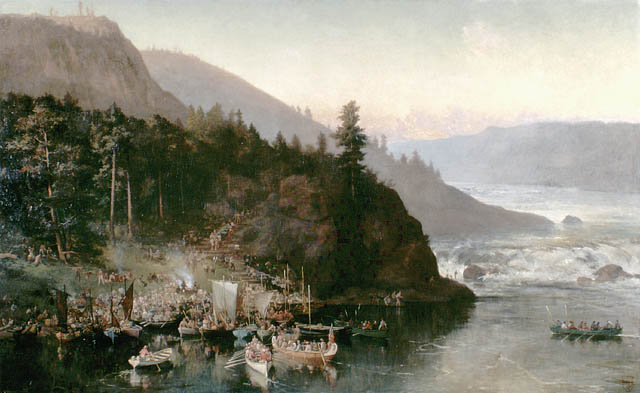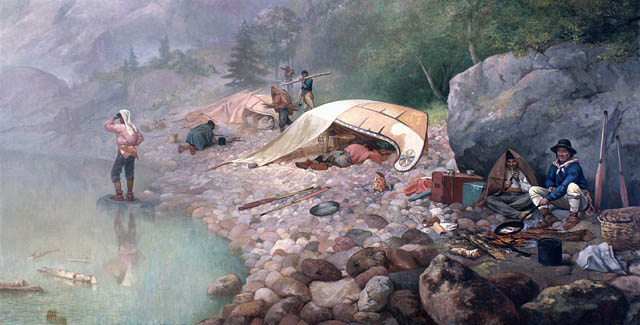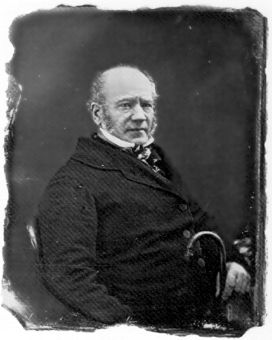Frances Anne Hopkins, artist (born 2 February 1838 in the United Kingdom; died 5 March 1919 in London, United Kingdom). Frances Anne Hopkins was an artist who sketched and painted Canadian landscapes. Her most famous paintings, including Shooting the Rapids and Canoes in a Fog, Lake Superior, depict long-distance canoe voyages undertaken by the Hudson’s Bay Company in the 1860s.

A Family of Artists
Frances Anne Hopkins was born in England in 1838, the third of five children of Frederick William Beechey and Charlotte Stapleton. Her father was an artist, a naval officer and an explorer who sailed with Sir John Franklin and Sir William Edward Parry. There were several other artists in the Beechey family. Hopkins’s grandfather Sir William Beechey (1753–1839) was a portrait painter to King George III’s consort, Queen Charlotte. Her grandmother Lady Beechey (1764–1833), née Anne Phyllis Jessop, exhibited her drawings and miniature portraits at the Royal Academy of Arts.
Little is known about Hopkins’s early life and education, but it’s likely that she received some instruction in drawing and watercolour painting as there were several artists in her extended family and these abilities were considered suitable accomplishments for upper-middle-class Englishwomen in the 19th century.
Marriage and Children
In 1858, 20-year-old Frances Anne Beechey married Edward Martin Hopkins, a widower 18 years her senior who had three young children; Hopkins met him in 1855, when his brother married one of her sisters. The couple had five children together, three of whom survived infancy: Raymond, Wilfred and Olive. Edward Hopkins encouraged her artistic endeavours. His grandson Edward Manley Hopkins explained to historian Grace Lee Nute in 1945, “While raising a family of her own and looking after her three stepsons…she nevertheless managed to travel extensively with her husband. It was he, I believe, as much as anyone who encouraged her artistic bent.”
Hudson’s Bay Company
Edward Hopkins was the personal secretary to Sir George Simpson, governor of the Hudson’s Bay Company. Frances Anne Hopkins travelled to Canada with her new husband and stepchildren soon after her marriage in 1858. The family settled in Lachine, where she sketched local landscapes, people and winter pastimes. Hopkins was one of the few women present at the Hudson’s Bay Company grand canoe reception during the royal tour by Queen Victoria’s eldest son, the future King Edward VII. At Edward VII’s request, Hopkins painted The visit of the Prince of Wales (Edward VII) to Lachine Rapids, Canada, in 1860, which was exhibited at the Royal Academy of Arts in London in 1902 — his coronation year.
Upon Simpson’s death in 1860, Edward Hopkins became the administrator for the Hudson’s Bay Company in Eastern Canada. Frances Anne Hopkins assumed a prominent role in Montreal society and accompanied her husband on at least three long-distance canoe voyages on the Great Lakes: northwest of Ottawa in 1866 and to Lake Superior in 1868 and 1869. She may have also visited Port Arthur in 1870 and painted The Red River Expedition at Kakabeka Falls in 1877.
On her travels across the Great Lakes, Hopkins may have been inspired by Anna Brownell Jameson, author of Winter Studies and Summer Rambles in Canada (1838), who sketched her own canoe voyages on Lake Huron. Hopkins would have also been familiar with the works of Paul Kane, who was commissioned by Simpson.

Voyageur Paintings
Frances Anne Hopkins lived in Canada during the final decades of long-distance canoe travel as a means of transportation for the Hudson’s Bay Company. Her paintings serve as a valuable historical record of these fur-trading voyages before the introduction of steamships and the railway. From her travel sketches, Hopkins developed large oil paintings. While 19th-century paintings of Canadian landscapes often focused on seemingly empty wilderness or lone figures, Hopkins’s paintings depicted large groups of Hudson’s Bay Company traders and Indigenous peoples working together to navigate the Great Lakes. In common with her contemporary, Princess Louise, she included miniature self-portraits in her artistic renderings of Canadian landscapes, often depicting herself seated with her sketchbook next to her husband in a canoe.

Exhibitions
Frances Anne Hopkins was one of the first female artists to present a solo collection at the Art Association of Montreal, exhibiting 16 of her watercolours in 1870. Her large canvas oil paintings were exhibited regularly at the Royal Academy of Arts in the late 19th and early 20th centuries, beginning with Canoes in a Fog, Lake Superior in 1869, which she had painted following her 1868 canoe journey.
In addition to her regular contributions to the Royal Academy of Arts, Hopkins corresponded with Canadian art dealers and collectors after her return to the United Kingdom in 1870, but she had difficulty selling her paintings in Canada. In a 1910 letter to David Ross McCord, founder of the McCord Museum in Montreal, she wrote, “I have several pictures of Canadian interest taken by myself in old times, and which, with the canoes, are unique. One is of the old Manor House at Quebec – Montcalm’s residence…I have not found Canadians at all interested hitherto for pictures of their own country. I sent some very nice ones to a Montreal art dealer, but they did not sell.”

Later Life
In 1869, Edward Hopkins retired from the Hudson’s Bay Company. He returned to England with his family in 1870. After her husband’s death in 1893, Frances Anne Hopkins opened an art studio in her home in Hampstead, London. According to Edward Manley Hopkins, “The prolonged depression of the 1880s had its effect on my grandfather’s estate. Although his widow was far from penniless, the ready sale of her pictures in the next decades brought not unwelcome addition to her income.” She continued to travel and exhibit her work until the First World War, regularly spending summers in France and visiting her son Raymond in Cape Town in 1908–10, where she painted South African landscapes.
Legacy
In 1921, Sir Arthur George Doughty, first Dominion archivist of Canada, acquired five of Frances Anne Hopkins’s paintings. They were exhibited in a gallery of historical paintings that was opened to the public in 1922. Although Hopkins’s paintings appeared frequently as illustrations in Canadian history books and memoirs, the artist herself fell into obscurity as these images were often uncredited.
Hopkins became better known in 1988, when her photograph appeared on a Canadian stamp with an image of her 1869 painting Canoe Manned by Voyageurs Passing a Waterfall. In 1990, the Thunder Bay Art Gallery organized the first major exhibition of Hopkins’s works. Art historian Robert Stacey stated, “Her works need to be rescued from the dusty vaults of historical illustration, archival documentation and sociological inquest and restored to their proper place: the repository of the living imagination.”

In 2018, Canadian photographer Naomi Harris travelled from Lachine to Kakabeka Falls by canoe, wearing a 19th-century period costume, following a fur-trading route that Hopkins would have travelled. Harris told the CBC, “I just became fascinated by the art…Who was the woman who accompanied these men, and what did it feel like for her to do the trip?” Harris’s multidisciplinary exhibition, entitled I, Voyageur: In Search of Frances Anne Hopkins, was displayed at the Thunder Bay Art Gallery.
Since then, Hopkins’s art has attracted more interest among curators and collectors. In May 2025, her watercolour sketch Canoes in a Fog, Lake Superior (1864) sold for $240,000 at auction — three times its estimated value. That month saw record-breaking sales of Canadian art, including historical scenes like those produced by Hopkins. Art critics and auction houses have linked this development to resurgent patriotism, prompted by tensions between Canada and the US and statements by US president Donald Trump that disparaged Canadian sovereignty.

 Share on Facebook
Share on Facebook Share on X
Share on X Share by Email
Share by Email Share on Google Classroom
Share on Google Classroom






